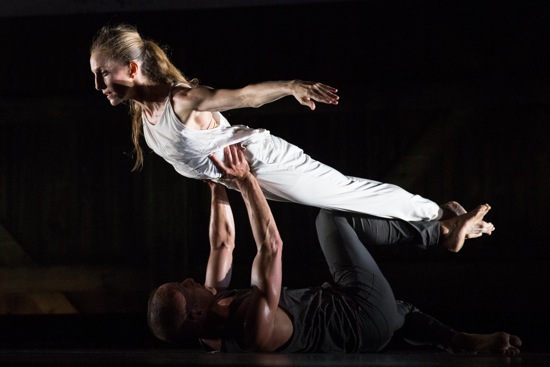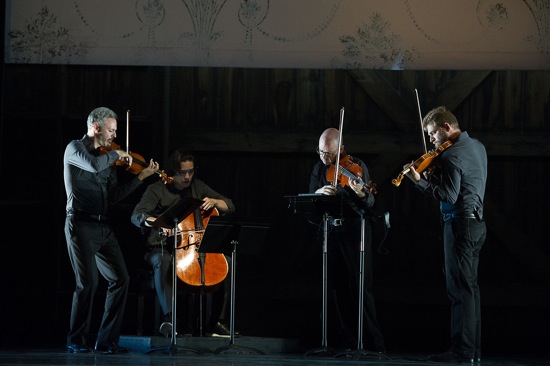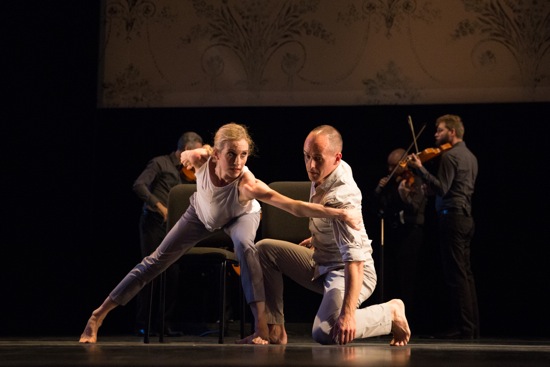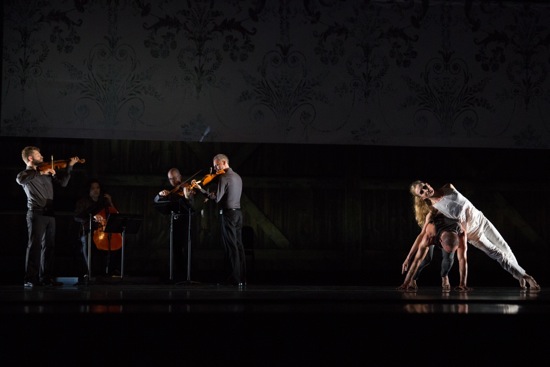Wendy Whelan, Brian Brooks, and Brooklyn Rider at Jacob’s Pillow, July 7-31

Brian Brooks and Wendy Whelan in Brooks’s Some of a Thousand Words. Photo: Hayim Heron
“Adventuress” isn’t a word I’d use to describe the marvelous dancer Wendy Whelan. Not because it’s a politically incorrect term in today’s porous and egalitarian vision of gender, but because it conjures up a glamorous, unprincipled woman using her charms in order to fleece men of their money or marry them. No, Whelan is an adventurer, one wandering from the world of the New York City Ballet, whose repertory she graced for thirty years, to the wilder shores of contemporary and postmodern dance.
In her aptly titled program, “Restless Creature,” which was presented at Jacob’s Pillow in 2013 and subsequently toured the country and beyond, she performed duets by and with their choreographers: Kyle Abraham, Joshua Beamish, Brian Brooks, and Alejandro Cerrudo. She and Brooks had created that duet at the Vail Festival in 2012, and they must have hit it off on a deeply creative level; they returned to the Pillow this summer with Some of a Thousand Words.
On her artistic travels, Whelan made discoveries beyond the dance styles and values that had shaped her. (Remember when Mikhail Baryshnikov stepped outside the ballet repertory, and how far his journey has taken him?) In 2014, she appeared at the Brooklyn Academy of Music in an adaptation of the Noh drama Hagoromo, directed by David Michalek and choreographed by David Neumann. In London, in 2015, five different choreographers (Javier De Frutos, Annie-B Parson, Arlene Phillips, Danièle Desnoyers, and Arthur Pita) created solos and duets for her and the Royal Ballet’s Edward Watson (“Watson/Whelan: Other Stories”).
Some of a Thousand Words shows what she has discovered on her artistic travels and what she is undoubtedly still learning. She wears no fancy costumes; her feet are bare; her hair either hangs down in a pigtail or a ponytail. Brooks has brought to the duet some of the values that have shaped his decidedly unballetic choreography for Brian Brooks Moving Company since 2002. His imaginative style plumbs the possibilities of repetition, and variation within that. It also requires a dancer capable of yielding to simultaneous impulses in different parts of the body with a demeanor that is relaxed and unaffected. To punish my travel metaphor further, I’d say that a duet for these two is like a road trip on which each of these diverse artists is concerned for the other’s comfort, and trust in his/her partner’s choices is a given. Whelan and Brooks onstage seem to “know” each other the way long-married couples do.

Brooklyn Rider. (L to R): Colin Jacobsen, Michael Nicolas, Nicholas Cords, and Johnny Gandelsman. Photo: Christopher Duggan
The curtain in the Ted Shawn Theater is open when the audience arrives, and it stays open for the hour and a quarter that Some of a Thousand Words lasts. The chairs and music stands that will be used by the dancers and/or the members of the adventurous string quartet Brooklyn Rider stand in a far corner beneath a high horizontal band across the stage that bears designs resembling black-and-white Victorian wallpaper. There will be no blackouts; the two dancers will enter together and stay, or one will go and the other remain behind to dance. Joe Levasseur’s sensitive lighting will dim slightly or brighten or change the look of the terrain entirely.
The quartet— Johnny Gandelsman (violin), Colin Jacobsen (violin), Nicolas Cords (viola), and Michael Nicolas (cello)—plays music by Jacob Cooper (Arches); by violinist Jacobsen (a new untitled score); by John Luther Adams (The Wind in High Places); by Tyondai Braxton (ArpRec1); and by Philip Glass (String Quartet #3 Mishima). Much of it has the sound of twelve-tone music—unafraid of dissonance, but not adhering to Arnold Schöenberg’s procedures.
Only a cello accompanies Whelan’s opening solo; at some point, a deep recorded hum underlies and threads through Nicolas’s playing of Cooper’s Arches. Whelan, who’s wearing gray pants and a loose, sleeveless white blouse (costumes: Karen Young), begins lying on the floor, and for a while we watch her fluidly roll, stretch one leg over the other, sit up, and, without stopping, melt down again. From the time she stands, she rarely stops swinging her arms loosely around her body, letting them pull her shoulders and torso into the action. Gradually other elements enter her vocabulary: she reaches out into the space, suspends a step for the duration of a breath, raises a leg casually off the floor, pushes into a low leap, covers more ground. Her tempo speeds up, then slows down. Nicolas bows rapidly on his instrument, and a deep electronic (?) throbbing wells up beneath that. Whelan returns to some of her earlier moves in condensed form, sliding smoothly to the floor and rising.
She’s very beautiful in this—relaxed, but clear, and serious about what she’s doing. Never does she seem hurried or pressured. The musicians enter and take their places: So does Brooks. And I notice something else about Whelan. Her focus is admirable. She sees the space around her, sees her partner. The practice of dancing, she seems to say, needs you to be watchful; you don’t just do it blindly. As she and Brooks embark on the next section, I wish he would show us more often that he not only senses her, but sees her too.
When Brooks has finished placing two chairs side by side, and Whelan has joined him. Brooklyn Rider begins to play Jacobsen’s compelling original score. Brooks and Whelan stand on the chairs, staring forward, bend, and, in perfect unison, sit on them. Here’s one strategy: Brooks moves one or both chairs into a new place onstage, mostly facing us; Whelan stands on one and tilts sideways, straight as a board, until she falls into his arms. Then he puts her down and she climbs onto another chair. They do this in various ways a number of times, and every time your heart hesitates until he catches her.

Wendy Whelan and Brian Brooks in Some of a Thousand Words. At back: Brooklyn Rider. Photo: Hayim Heron
The music turns briefly perky, darkens, brightens again. Whelan and Brooks sit side by side and enlace their arms and fold their bodies around each other in complicated, complementary ways; now one of them slumps, relaxing, in the chair, but only briefly; for a few seconds, one of them seems to dominate the other, but the image slides away before you can grasp it. Brooks slips off his chair but oozes back onto it. They also reach out and scoop up air in mirror-image unison. They never lose their identity as everyday humans, but you can also sense them as forces heaving, diverting, flowing together.
Brooks is a prince of three-dimensionality. In his solo, he keeps fairly grounded, his knees most often bent, and sets up a conversation with the various parts of his body. Moving with the weighted fluidity of molasses, he makes his shoulders, or one of them, lead his body in one direction; then an elbow may pull his arms elsewhere. His legs respond, but rarely take a lead. He seems always to be turning, coiling and shifting; sometimes I see him as a man trying to shrug his way out of a confining garment. When the two dance together contrapuntally, you can see that even when they fall into unison, they’re different—she sleeker and slightly more controlled, he sturdier and a tiny bit rougher around the edges, his sinuousness more deeply rooted.
There’s no intermission; instead, there’s a musical interlude, in which the members of Brooklyn Rider have the stage to themselves while they play the fascinating piece by Braxton that showcases their virtuosity as individuals and as an ensemble. The music for the final duet is Philip Glass’s String Quartet #3 Mishima, and the dancers venture into trickier, more expansive material, referencing a ballet pas de deux in terms of contact and of support of Whelan by Brooks, without being in the least balletic.
It begins with Brooks putting his arms around Whelan from behind to begin one of those unstopping slippages of their arms and bodies that merge embracing with deflecting, inviting with evading, reaching over with ducking under. All the while, the two remain close to each other, except for the punctuating moments in which they pull apart, linked by a handclasp, and pause almost imperceptibly.

Wendy Whelan and Brian Brooks in Some of a Thousand Words, with (L to R) Colin Jacobsen, Michael Nicolas, Nicholas Cords, and Johnny Gandelsman. Photo: Hayim Heron
The uncannily beautiful last section of this encounter stayed with me since I first saw it in First Fall on Whelan’s “Restless Creature” program. You can sample its beginnings at Vail by going to: https://www.youtube.com/watch?v=wBQTTBZ7hWE.
Whelan is all in white now. She stands facing us, but staring beyond us, while, behind her and pressed against her, Brooks begins to bend down. She falls straight back over him. That’s the basic mechanics of the move, but words can’t fully convey the breathtaking image of faithfulness and trust that it conveys. Traveling together, the two seem never to stop moving. When she senses him and falls, she presses him to the floor, and as he pushes himself up into crawling on his hands and feet, she rolls onto her side and walks along with him, holding herself in a long slanting line, not fully yielding. Rising bit by bit, he brings her upright, never touching her with his hands. Sometimes she faces him to fall, her arms spread as in a swan dive.
Whelan and Brooks perform this maneuver and variants of it a number of times before ending as Whelan began the evening, lying on the floor; now, however, she’s no longer alone. Throughout this duet, they dance almost without emphasis, as if the startling acts were something a man and woman might do together every day. He is the enabler, she the ambitious climber. And we imagine mountains and valleys.
